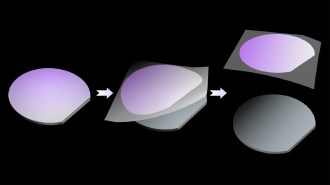Uncategorized
-
 Space
Space50 years ago, astronomers saw the surface of a distant star for the first time
In the 1970s, technological advances let scientists peer through stars’ atmospheres. Now, scientists can measure roiling gas in the stars themselves.
-
 Health & Medicine
Health & MedicineTelehealth helps people get health care, but access may soon be in limbo
COVID-era telehealth laws made health care more accessible for rural patients, but telehealth might not be as easy to access next year.
By Sophie Hartley and Andrea Tamayo -
 Health & Medicine
Health & MedicineStage 0 breast cancer patients may not need to rush to surgery
Women with Stage 0 breast cancer who got biannual mammograms and delayed surgery for two years fared as well as those who got immediate surgery.
-
 Life
LifeThese scientific feats set new records in 2024
Noteworthy findings include jumbo black hole jets, an ultrapetite frog, ancient asteroid remnants and more.
-

-
 Health & Medicine
Health & MedicineDeaths related to the cold have grown since 1999 in the U.S.
From 1999 to 2022, the rate of cold-related deaths rose from about 4 per 1 million people to 9 per 1 million in the United States.
-
 Artificial Intelligence
Artificial IntelligenceAI sniffs out whiskey flavor notes as well as the pros
A machine learning algorithm identified the top five flavor notes in 16 types of whiskey. Each matched the aggregate of what a panel of human pros said.
-
 Chemistry
ChemistryA new microbead proves effective as a plastic-free skin scrubber
The nonplastic polymer cleaned up eyeliner and permanent marker and broke down into molecules related to sugar and amino acids.
By Skyler Ware -
 Space
SpaceWhat will space exploration look like under Trump?
A lot is unknown, but the roles of billionaires like Elon Musk and Jared Isaacman suggests a focus on human and private spaceflight.
-
 Health & Medicine
Health & MedicineHere’s how public health fared in 2024
Viral outbreaks, extreme heat and access to clean water are among the year’s big public health headlines.
-
 Materials Science
Materials ScienceScotch tape is key to creating thin films of diamond
The sticky stuff helped peel sheets of diamond less than a micrometer thick off silicon wafers, creating membranes useful for electronic devices.
-
 Life
LifeThese are our favorite animal stories of 2024
Pigeons that do somersaults, snakes that fake death with extra flair and surprised canines are among the organisms that enthralled the Science News staff.